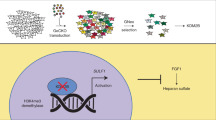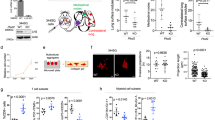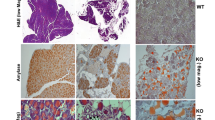Abstract
Heparan sulfate (HS) proteoglycans (HSPGs) bind to multiple growth factors/morphogens and regulate their signaling. 6-O-sulfation (6S) of glucosamine within HS chains is critical for many of these ligand interactions. Sulf-1 and Sulf-2, which are extracellular neutral-pH sulfatases, provide a novel post-synthetic mechanism for regulation of HSPG function by removing 6S from intact HS chains. The Sulfs can thereby modulate several signaling pathways, including the promotion of Wnt signaling. We found induction of SULF2 transcripts and Sulf-2 protein in human lung adenocarcinoma and squamous cell carcinoma, the two major classes of non-small-cell lung carcinomas (NSCLCs). We confirmed widespread Sulf-2 protein expression in tumor cells of 10/10 surgical specimens of human lung squamous carcinomas. We studied five Sulf-2+ NSCLC cell lines, including two, which were derived by cigarette-smoke transformation of bronchial epithelial cells. shRNA-mediated Sulf-2 knockdown in these lines caused an increase in 6S on their cell surface and in parallel reversed their transformed phenotype in vitro, eliminated autocrine Wnt signaling and strongly blunted xenograft tumor formation in nude mice. Conversely, forced Sulf-2 expression in non-malignant bronchial epithelial cells produced a partially transformed phenotype. Our findings support an essential role for Sulf-2 in lung cancer, the leading cancer killer.
This is a preview of subscription content, access via your institution
Access options
Subscribe to this journal
Receive 50 print issues and online access
$259.00 per year
only $5.18 per issue
Buy this article
- Purchase on Springer Link
- Instant access to full article PDF
Prices may be subject to local taxes which are calculated during checkout






Similar content being viewed by others
References
Ai X, Do AT, Lozynska O, Kusche-Gullberg M, Lindahl U, Emerson Jr CP . (2003). QSulf1 remodels the 6-O sulfation states of cell surface heparan sulfate proteoglycans to promote Wnt signaling. J Cell Biol 162: 341–351.
Ai X, Kitazawa T, Do A-T, Kusche-Gullberg M, Labosky PA, Emerson Jr CP . (2007). SULF1 and SULF2 regulate heparan sulfate-mediated GDNF signaling for esophageal innervation. Development 134: 3327–3338.
Aikawa T, Whipple CA, Lopez ME, Gunn J, Young A, Lander AD et al. (2008). Glypican-1 modulates the angiogenic and metastatic potential of human and mouse cancer cells. J Clin Invest 118: 89–99.
Alexander CM, Reichsman F, Hinkes MT, Lincecum J, Becker KA, Cumberledge S et al. (2000). Syndecan-1 is required for Wnt-1-induced mammary tumorigenesis in mice. Nat Genet 25: 329–332.
Bafico A, Liu G, Goldin L, Harris V, Aaronson SA . (2004). An autocrine mechanism for constitutive Wnt pathway activation in human cancer cells. Cancer Cell 6: 497–506.
Bernfield M, Gotte M, Park PW, Reizes O, Fitzgerald ML, Lincecum J et al. (1999). Functions of cell surface heparan sulfate proteoglycans. Annu Rev Biochem 68: 729–777.
Bishop JR, Schuksz M, Esko JD . (2007). Heparan sulphate proteoglycans fine-tune mammalian physiology. Nature 446: 1030–1037.
Brickman YG, Ford MD, Gallagher JT, Nurcombe V, Bartlett PF, Turnbull JE . (1998). Structural modification of fibroblast growth factor-binding heparan sulfate at a determinative stage of neural development. J Biol Chem 273: 4350–4359.
Capurro MI, Xiang YY, Lobe C, Filmus J . (2005). Glypican-3 promotes the growth of hepatocellular carcinoma by stimulating canonical Wnt signaling. Cancer Res 65: 6245–6254.
Castro NP, Osorio CA, Torres C, Bastos EP, Mourao-Neto M, Soares FA et al. (2008). Evidence that molecular changes in cells occur before morphological alterations during the progression of breast ductal carcinoma. Breast Cancer Res 10: R87.
Clevers H . (2006). Wnt/beta-catenin signaling in development and disease. Cell 127: 469–480.
Dai Y, Yang Y, MacLeod V, Yue X, Rapraeger AC, Shriver Z et al. (2005). HSulf-1 and HSulf-2 are potent inhibitors of myeloma tumor growth in vivo. J Biol Chem 280: 40066–40073.
Danesin C, Agius E, Escalas N, Ai X, Emerson C, Cochard P et al. (2006). Ventral neural progenitors switch toward an oligodendroglial fate in response to increased Sonic Hedgehog (Shh) activity: involvement of sulfatase 1 in modulating Shh signaling in the ventral spinal cord. J Neurosci 26: 5037–5048.
DeAlmeida VI, Miao L, Ernst JA, Koeppen H, Polakis P, Rubinfeld B . (2007). The soluble Wnt receptor Frizzled8CRD-hFc inhibits the growth of teratocarcinomas in vivo. Cancer Res 67: 5371–5379.
Dennissen MA, Jenniskens GJ, Pieffers M, Versteeg EM, Petitou M, Veerkamp JH et al. (2002). Large, tissue-regulated domain diversity of heparan sulfates demonstrated by phage display antibodies. J Biol Chem 277: 10982–10986.
Derksen PW, Tjin E, Meijer HP, Klok MD, MacGillavry HD, van Oers MH et al. (2004). Illegitimate WNT signaling promotes proliferation of multiple myeloma cells. Proc Natl Acad Sci USA 101: 6122–6127.
Dhoot GK, Gustafsson MK, Ai X, Sun W, Standiford DM, Emerson Jr CP . (2001). Regulation of Wnt signaling and embryo patterning by an extracellular sulfatase. Science 293: 1663–1666.
Esko JD, Lindahl U . (2001). Molecular diversity of heparan sulfate. J Clin Invest 108: 169–173.
Freeman SD, Moore WM, Guiral EC, Holme AD, Turnbull JE, Pownall ME . (2008). Extracellular regulation of developmental cell signaling by XtSulf1. Dev Biol 320: 436–445.
Furuuchi K, Tada M, Yamada H, Kataoka A, Furuuchi N, Hamada J et al. (2000). Somatic mutations of the APC gene in primary breast cancers. Am J Pathol 156: 1997–2005.
Fuster MM, Esko JD . (2005). The sweet and sour of cancer: glycans as novel therapeutic targets. Nat Rev Cancer 5: 526–542.
Gallagher JT . (2001). Heparan sulfate: growth control with a restricted sequence menu. J Clin Invest 108: 357–361.
Grigoriadis A, Mackay A, Reis-Filho JS, Steele D, Iseli C, Stevenson BJ et al. (2006). Establishment of the epithelial-specific transcriptome of normal and malignant human breast cells based on MPSS and array expression data. Breast Cancer Res 8: R56.
Groen RWJ, Oud MECM, Schilder-Tol EJM, Overdijk MB, ten Berge D, Nusse R et al. (2008). Illegitimate WNT pathway activation by {beta}-catenin mutation or autocrine stimulation in T-cell malignancies. Cancer Res 68: 6969–6977.
Habuchi H, Habuchi O, Kimata K . (2004). Sulfation pattern in glycosaminoglycan: does it have a code? Glycoconj J 21: 47–52.
Habuchi H, Nagai N, Sugaya N, Atsumi F, Stevens RL, Kimata K . (2007). Mice deficient in heparan sulfate 6-O-sulfotransferase-1 exhibit defective heparan sulfate biosynthesis, abnormal placentation, and late embryonic lethality. J Biol Chem 282: 15578–15588.
Hoang BH, Kubo T, Healey JH, Sowers R, Mazza B, Yang R et al. (2004). Expression of LDL receptor-related protein 5 (LRP5) as a novel marker for disease progression in high-grade osteosarcoma. Int J Cancer 109: 106–111.
Holst CR, Bou-Reslan H, Gore BB, Wong K, Grant D, Chalasani S et al. (2007). Secreted sulfatases Sulf1 and Sulf2 have overlapping yet essential roles in mouse neonatal survival. PLoS ONE 2: e575.
Hossain MM, Hosono T, Tang R, van Kuppevelt TH, Jenniskens GJ, Rosen SD et al. (2009). Direct detection of HSulf-1 and HSulf-2 activities on extracellular heparan sulfate and their inhibition by PI-88. Glycobiology (e-pub ahead of print 12 October 2009).
Huang CL, Liu D, Ishikawa S, Nakashima T, Nakashima N, Yokomise H et al. (2008). Wnt1 overexpression promotes tumour progression in non-small cell lung cancer. Eur J Cancer 44: 2680–2688.
Huguet EL, McMahon JA, McMahon AP, Bicknell R, Harris AL . (1994). Differential expression of human Wnt genes 2, 3, 4, and 7B in human breast cell lines and normal and disease states of human breast tissue. Cancer Res 54: 2615–2621.
Janssens N, Andries L, Janicot M, Perera T, Bakker A . (2004). Alteration of frizzled expression in renal cell carcinoma. Tumour Biol 25: 161–171.
Johansson FK, Brodd J, Eklof C, Ferletta M, Hesselager G, Tiger CF et al. (2004). Identification of candidate cancer-causing genes in mouse brain tumors by retroviral tagging. Proc Natl Acad Sci USA 101: 11334–11337.
Kawano Y, Kypta R . (2003). Secreted antagonists of the Wnt signalling pathway. J Cell Sci 116: 2627–2634.
Kim J, You L, Xu Z, Kuchenbecker K, Raz D, He B et al. (2007). Wnt inhibitory factor inhibits lung cancer cell growth. J Thorac Cardiovasc Surg 133: 733–737.
Klaus A, Birchmeier W . (2008). Wnt signalling and its impact on development and cancer. Nat Rev Cancer 8: 387–398.
Kudo Y, Ogawa I, Kitajima S, Kitagawa M, Kawai H, Gaffney PM et al. (2006). Periostin promotes invasion and anchorage-independent growth in the metastatic process of head and neck cancer. Cancer Res 66: 6928–6935.
Lai J, Chien J, Staub J, Avula R, Greene EL, Matthews TA et al. (2003). Loss of HSulf-1 upregulates heparin-binding growth factor signaling in cancer. J Biol Chem 278: 23107–23117.
Lai JP, Chien JR, Moser DR, Staub JK, Aderca I, Montoya DP et al. (2004). hSulf1 sulfatase promotes apoptosis of hepatocellular cancer cells by decreasing heparin-binding growth factor signaling. Gastroenterology 126: 231–248.
Lai JP, Sandhu DS, Yu C, Han T, Moser CD, Jackson KK et al. (2008). Sulfatase 2 upregulates glypican 3, promotes fibroblast growth factor signaling, and decreases survival in hepatocellular carcinoma. Hepatology 47: 1211–1222.
Lamanna WC, Frese MA, Balleininger M, Dierks T . (2008). Sulf loss influences N-, 2-O-, and 6-O-sulfation of multiple heparan sulfate proteoglycans and modulates fibroblast growth factor signaling. J Biol Chem 283: 27724–27735.
Langsdorf A, Do AT, Kusche-Gullberg M, Emerson Jr CP, Ai X . (2007). Sulfs are regulators of growth factor signaling for satellite cell differentiation and muscle regeneration. Dev Biol 311: 464–477.
Lemjabbar-Alaoui H, Dasari V, Sidhu SS, Mengistab A, Finkbeiner W, Gallup M et al. (2006). Wnt and Hedgehog are critical mediators of cigarette smoke-induced lung cancer. PLoS ONE 1: e93.
Li J, Kleeff J, Abiatari I, Kayed H, Giese NA, Felix K et al. (2005). Enhanced levels of Hsulf-1 interfere with heparin-binding growth factor signaling in pancreatic cancer. Mol Cancer 4: 14.
Logan CY, Nusse R . (2004). The Wnt signaling pathway in development and disease. Annu Rev Cell Dev Biol 20: 781–810.
Lum DH, Tan JH, Rosen SD, Werb Z . (2006). Gene trap disruption of the mouse heparan sulfate 6-O endosulfatase, Sulf2. Mol Cell Biol 27: 678–688.
Mazieres J, He B, You L, Xu Z, Lee AY, Mikami I et al. (2004). Wnt inhibitory factor-1 is silenced by promoter hypermethylation in human lung cancer. Cancer Res 64: 4717–4720.
Mikami I, You L, He B, Xu Z, Batra S, Lee AY et al. (2005). Efficacy of Wnt-1 monoclonal antibody in sarcoma cells. BMC Cancer 5: 53.
Miller JR, Hocking AM, Brown JD, Moon RT . (1999). Mechanism and function of signal transduction by the Wnt/beta-catenin and Wnt/Ca2+ pathways. Oncogene 18: 7860–7872.
Morimoto-Tomita M, Uchimura K, Bistrup A, Lum DH, Egeblad M, Boudreau N et al. (2005). Sulf-2, a proangiogenic heparan sulfate endosulfatase, is upregulated in breast cancer. Neoplasia 7: 1001–1010.
Morimoto-Tomita M, Uchimura K, Werb Z, Hemmerich S, Rosen SD . (2002). Cloning and characterization of two extracellular heparin-degrading endosulfatases in mice and humans. J Biol Chem 277: 49175–49185.
Nakashima T, Liu D, Nakano J, Ishikawa S, Yokomise H, Ueno M et al. (2008). Wnt1 overexpression associated with tumor proliferation and a poor prognosis in non-small cell lung cancer patients. Oncol Rep 19: 203–209.
Nawroth R, van Zante A, Cervantes S, McManus M, Hebrok M, Rosen SD . (2007). Extracellular sulfatases, elements of the wnt signaling pathway, positively regulate growth and tumorigenicity of human pancreatic cancer cells. PLoS ONE 2: e392.
Ohgaki H, Kros JM, Okamoto Y, Gaspert A, Huang H, Kurrer MO . (2004). APC mutations are infrequent but present in human lung cancer. Cancer Lett 207: 197–203.
Osada H, Takahashi T . (2002). Genetic alterations of multiple tumor suppressors and oncogenes in the carcinogenesis and progression of lung cancer. Oncogene 21: 7421–7434.
Parish CR, Freeman C, Hulett MD . (2001). Heparanase: a key enzyme involved in cell invasion. Biochim Biophys Acta 1471: M99–M108.
Ratzka A, Kalus I, Moser M, Dierks T, Mundlos S, Vortkamp A . (2008). Redundant function of the heparan sulfate 6-O-endosulfatases Sulf1 and Sulf2 during skeletal development. Dev Dyn 237: 339–353.
Sato M, Shames DS, Gazdar AF, Minna JD . (2007). A translational view of the molecular pathogenesis of lung cancer. J Thorac Oncol 2: 327–343.
Schlange T, Matsuda Y, Lienhard S, Huber A, Hynes NE . (2007). Autocrine WNT signaling contributes to breast cancer cell proliferation via the canonical WNT pathway and EGFR transactivation. Breast Cancer Res 9: R63.
Sjoblom T, Jones S, Wood LD, Parsons DW, Lin J, Barber TD et al. (2006). The consensus coding sequences of human breast and colorectal cancers. Science 314: 268–274.
Sunaga N, Kohno T, Kolligs FT, Fearon ER, Saito R, Yokota J . (2001). Constitutive activation of the Wnt signaling pathway by CTNNB1 (beta-catenin) mutations in a subset of human lung adenocarcinoma. Genes Chromosomes Cancer 30: 316–321.
Suzuki H, Watkins DN, Jair KW, Schuebel KE, Markowitz SD, Chen WD et al. (2004). Epigenetic inactivation of SFRP genes allows constitutive WNT signaling in colorectal cancer. Nat Genet 36: 417–422.
Tang R, Rosen SD . (2009). Functional consequences of the subdomain organization of the sulfs. J Biol Chem 284: 21505–21514.
Uchimura K, Morimoto-Tomita M, Bistrup A, Li J, Lyon M, Gallagher J et al. (2006). HSulf-2, an extracellular endoglucosamine-6-sulfatase, selectively mobilizes heparin-bound growth factors and chemokines: effects on VEGF, FGF-1, and SDF-1. BMC Biochem 7: 2.
Uematsu K, He B, You L, Xu Z, McCormick F, Jablons DM . (2003). Activation of the Wnt pathway in non small cell lung cancer: evidence of dishevelled overexpression. Oncogene 22: 7218–7221.
Viviano BL, Paine-Saunders S, Gasiunas N, Gallagher J, Saunders S . (2004). Domain-specific modification of heparan sulfate by Qsulf1 modulates the binding of the bone morphogenetic protein antagonist Noggin. J Biol Chem 279: 5604–5611.
Vlodavsky I, Ilan N, Naggi A, Casu B . (2007). Heparanase: structure, biological functions, and inhibition by heparin-derived mimetics of heparan sulfate. Curr Pharm Des 13: 2057–2073.
Wang S, Ai X, Freeman SD, Pownall ME, Lu Q, Kessler DS et al. (2004). QSulf1, a heparan sulfate 6-O-endosulfatase, inhibits fibroblast growth factor signaling in mesoderm induction and angiogenesis. Proc Natl Acad Sci USA 101: 4833–4838.
Winn RA, Van Scoyk M, Hammond M, Rodriguez K, Crossno Jr JT, Heasley LE et al. (2006). Antitumorigenic Effect of Wnt 7a and Fzd 9 in non-small cell lung cancer cells is mediated through ERK-5-dependent activation of peroxisome proliferator-activated receptor {gamma}. J Biol Chem 281: 26943–26950.
You L, He B, Xu Z, Uematsu K, Mazieres J, Mikami I et al. (2004). Inhibition of Wnt-2-mediated signaling induces programmed cell death in non-small-cell lung cancer cells. Oncogene 23: 6170–6174.
Acknowledgements
RB4CD12 was a kind gift from Drs Guido Jenniskens and Toin van Kuppevelt of Nijmegen Medical Center. We thank Dr Roman Nawroth for preliminary work with lung cancer cell lines. We thank Drs Zena Werb, Joanna Phillips and Inna Maltseva for comments on the paper. This work was performed with support from the Tobacco-Related Disease Research Program of the University of California Grant 17RT-0216, NIH P01 AI053194 and NIH R21 CA122025; Susan Komen Breast Cancer Foundation PDF0402844 to SDR; NIH RO1 HL075602 to Dr Zena Werb; The Larry Hall and Zygielbaum Memorial Trust, and The Kazan, McClain, Edises, Abrams, Fernandez, Lyons & Farrise Foundation to DMJ and NIH R01CA125030 to BH.
Author information
Authors and Affiliations
Corresponding author
Additional information
Supplementary Information accompanies the paper on the Oncogene website (http://www.nature.com/onc)
Supplementary information
Rights and permissions
About this article
Cite this article
Lemjabbar-Alaoui, H., van Zante, A., Singer, M. et al. Sulf-2, a heparan sulfate endosulfatase, promotes human lung carcinogenesis. Oncogene 29, 635–646 (2010). https://doi.org/10.1038/onc.2009.365
Received:
Revised:
Accepted:
Published:
Issue Date:
DOI: https://doi.org/10.1038/onc.2009.365
Keywords
This article is cited by
-
Antitumor activity of adiponectin in mice model of skin cancer via modulation of sulfatase-2 and MMP9 activity on HSPGs
Biologia (2022)
-
Changes in heparan sulfate sulfotransferases and cell-surface heparan sulfate during SKM-1 cells granulocytic differentiation and A549 cells epithelial-mesenchymal transition
Glycoconjugate Journal (2020)
-
Targeting acquired oncogenic burden in resilient pancreatic cancer: a novel benefit from marine polyphenols
Molecular and Cellular Biochemistry (2019)
-
The “in and out” of glucosamine 6-O-sulfation: the 6th sense of heparan sulfate
Glycoconjugate Journal (2017)
-
Sulfatase-2: a prognostic biomarker and candidate therapeutic target in patients with pancreatic ductal adenocarcinoma
British Journal of Cancer (2016)



